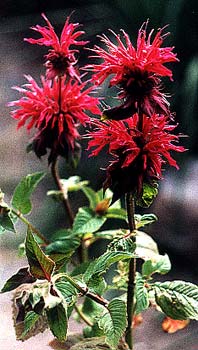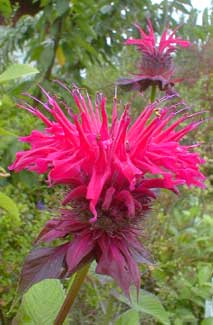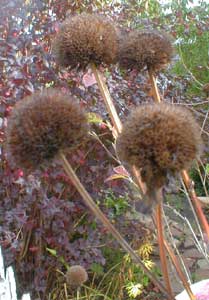
'Raspberry Wine'
Bee Balm
"I have lov'd flowers that fade,
Within whose magic tents
Rich hues have marriage made
With sweet unmemoried scents."
-Robert Seymour Bridges
(1844-1930)
(1844-1930)
The July (2002) portrait at the left looks like four ruby-red blossoms, right? It's only two! The bee balm Monarda didyma 'Raspberry Wine' literally has a full-sized flower growing on top of a full-sized flower.
Not every blossom appears in tandems like this, but enough do so to add an extra oomph of odd elegance. In my estimation, with its bright red petals & pink sepals, it is the most beautiful of all bee balms, yet it has lost none of the hardiness of less ornate varieties.
 Hummingbirds love bee balms, as do butterflies & of course bees. The name "bee balm" derives from the topical use of the aromatic leaves to relieve bee sting.
Hummingbirds love bee balms, as do butterflies & of course bees. The name "bee balm" derives from the topical use of the aromatic leaves to relieve bee sting.As a close relative of mint, the leaves have a sweet minty odor that most people will find very pleasant, but it may be too musky for right next to the door. The flowers have a mellower perfume largely overwhelmed by the leaf.
It loves full sun, does fine with part shade, & wants rich acid soil. It also wants persistently moist well draining soil but when established will tolerate short drought periods if it really has too.
It makes for gorgeous cut flowers that last a long while in bouquets, & it blooms all summer long, strongest at mid- to late-summer. Ours was growing a full four feet high to its bloom tips for its first two years, & by its third year some of the flowers rose to six feet.
 With even halfhearted deadheading it reblooms at least until September & sometimes well into October. Late in autumn it begins to be scruffy-looking & should just be cut to the ground or you'll end up getting increasingly unhappy with its appearance.
With even halfhearted deadheading it reblooms at least until September & sometimes well into October. Late in autumn it begins to be scruffy-looking & should just be cut to the ground or you'll end up getting increasingly unhappy with its appearance.Some of our bee balms get a powdery mildew on the leaves, & when this happens they are cut to the ground & the leaves & stems are discarded rather than composted, which seems to be enough to control the problem which does not appear until the beebalms are long finished with flowering in any case. 'Raspberry Wine' however has never yet experienced powdery mildew, so we let the foliage die back on its own, & don't cut the stems until they are well browned. This means the brown seedheads can remain in the garden a long while feeding finches & having an autumn decorativeness. The third photo is from October (2004), showing these attractive dried seedheads.
All bee balms spread rapidly & develop thick woody roots over time. Red Raspberry will easily clump to two feet wide, & can aggressively displace neighboring plants, so choose its companions accordingly. If grown in poor soil it will probably still do fairly well, but without wanting to spread so much. Every two to four years it can be divided, preferably in early spring.
We have a couple other bee balms, including purple M. didyma 'Marshall's Delight', which is also very beautiful because all bee balms are.